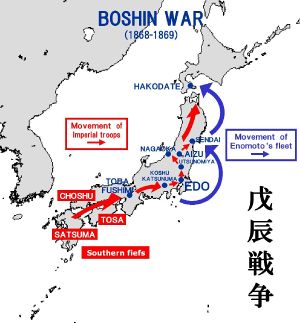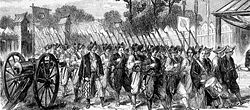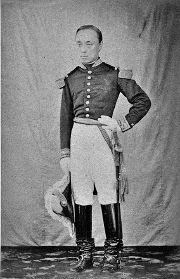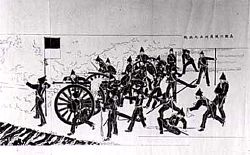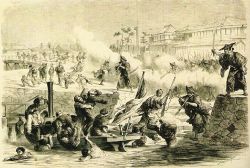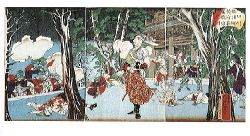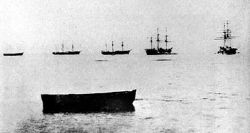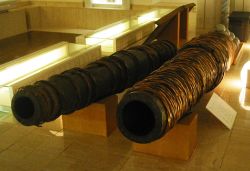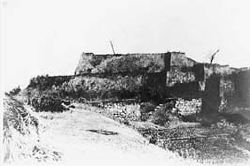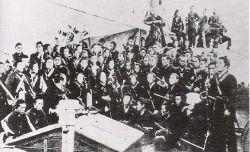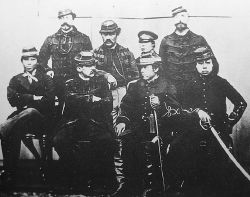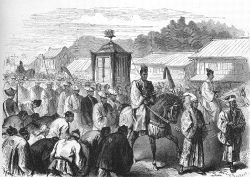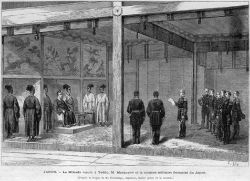Boshin War
| Boshin War æè¾°æ¦äº (1868â1869) | |||||||
|---|---|---|---|---|---|---|---|
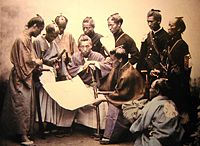 Samurai of the Satsuma clan, fighting for the Imperial side during the Boshin War period. Photograph by Felice Beato. | |||||||
| |||||||
| Combatants | |||||||
Satsuma Domain, ChÅshÅ« Domain, Tosa Domain, Saga Domain |
|||||||
| Commanders | |||||||
| Ruler: Meiji Emperor, CIC: SaigÅ Takamori, Army: Kuroda Kiyotaka |
Shogunate: Ruler: Tokugawa Yoshinobu, Army: Katsu Kaishu, Navy: Enomoto Takeaki, Ezo Republic: President:Enomoto Takeaki, CIC: Otori Keisuke, Navy: Arai Ikunosuke | ||||||
| Casualties | |||||||
| ~1,000 killed[1] | ~3,000 killed[1] | ||||||
The Boshin War (æè¾°æ¦äº Boshin SensÅ, "War of the Year of the Dragon") was a civil war in Japan, fought from 1868 to 1869 between forces of the ruling Tokugawa shogunate and those seeking to return political power to the imperial court. The war found its origins in dissatisfaction among many nobles and young samurai with the shogunate's handling of foreigners following the opening of Japan the prior decade. An alliance of southern samurai, particularly the domains of Choshu and Satsuma, and court officials secured control of the imperial court and influenced the young Emperor Meiji. Tokugawa Yoshinobu, the sitting shogun, realizing the futility of his situation, abdicated political power to the emperor. Yoshinobu had hoped that by doing this, the Tokugawa house could be preserved and to participate in the future government. However, military movements by imperial forces, partisan violence in Edo, and an imperial decree promoted by Satsuma and Choshu abolishing the house of Tokugawa led Yoshinobu to launch a military campaign to seize the emperor's court at Kyoto. The military tide rapidly turned in favor of the smaller but relatively modernized imperial faction, and after a series of battles culminating in the surrender of Edo, Yoshinobu personally surrendered. Those loyal to the Tokugawa retreated to northern HonshÅ« and later to HokkaidÅ, where they founded the Ezo republic.
Defeat at the Battle of Hakodate broke this last holdout and left the imperial rule supreme throughout the whole of Japan, completing the military phase of the Meiji Restoration. Around one hundred and twenty thousand men were mobilized during the conflict, and of these about three and a half thousand were killed. In the end, the victorious imperial faction abandoned its objective to expel foreigners from Japan and instead adopted a policy of continued modernization with an eye to eventual renegotiation of the Unequal Treaties with the Western powers. Due to the persistence of SaigÅ Takamori, a prominent leader of the imperial faction, the Tokugawa loyalists were shown clemency, and many former shogunate leaders were later given positions of responsibility under the new government. The Boshin War testifies to the advanced state of modernization already achieved by Japan barely 14 years after its opening to the West, the already high involvement of Western nations (especially the United Kingdom and France) in the country's politics, and the rather turbulent installation of Imperial power. The War contributed to Japan's more militant and expansionist polity that, in the next century, propelled her into imperial competition with other powers, to colonial ambition in Korea, Manchuria and further afield leading up to and during World War II. This war was internal but the momentum it generated spilled across the seas. Following defeat in 1945, Japan had redirected her creativity, ingenuity and energy into becoming an economic power, not a military one. Many people in Japan, originally a nation of "great harmony," feel that they should contribute their various resources for the sake of the world in order to atone for their past militaristic aggressions
Political Background
Early discontent against the Shogunate
For the two centuries prior to 1854, Japan had severely limited exchange with foreign nations, with the notable exceptions of Korea via Tsushima, Qing China via the RyÅ«kyÅ«s, and the Dutch through the trading post of Dejima.[2][3] In 1854, Commodore Perry opened Japan to global commerce with the implied threat of force, thus initiating a period of rapid development in foreign trade and Westernization. In large part due to the humiliating terms of the Unequal Treaties, as agreements like those conveyed by Perry are called, the Shogunate soon faced internal hostility, which materialized into a radical, xenophobic movement, the sonnÅ jÅi (literally "Revere the Emperor, expel the barbarians").[4]

The Emperor KÅmei agreed with such sentiments, andâbreaking with centuries of imperial traditionâbegan to take an active role in matters of state: as opportunities arose, he fulminated against the treaties and attempted to interfere in the shogunal succession. His efforts culminated in March 1863 with his "Order to expel barbarians." Although the Shogunate had no intention of enforcing the order, it nevertheless inspired attacks against the Shogunate itself and against foreigners in Japan: the most famous incident was that of the English trader Charles Lennox Richardson, for whose death the Tokugawa government had to pay an indemnity of one hundred thousand British pounds.[5] Other attacks included the shelling of foreign shipping in Shimonoseki.[6]
During 1864, these actions were successfully countered by armed retaliations by foreign powers, such as the British Bombardment of Kagoshima and the multinational Bombardment of Shimonoseki. At the same time, the forces of ChÅshÅ«, together with xenophobic ronin, raised the Hamaguri rebellion trying to seize the city of Kyoto, where the Emperor's court was held, but the future shogun Tokugawa Yoshinobu led a punitive expedition and defeated them. At this point initial resistance among the leadership in ChÅshÅ« and the imperial court subsided, but over the next year the Tokugawa proved unable to reassert full control over the country as most daimyo began to ignore orders and questions from Edo.[7]
Foreign military assistance
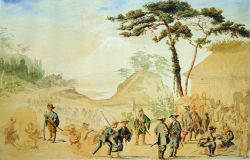
Despite the bombardment of Kagoshima, the Satsuma domain had become closer to the British and was pursuing the modernization of its army and navy with their support.[8] The Scottish dealer Thomas Blake Glover sold quantities of warships and guns to the southern domains.[9] American and British military experts, usually former officers, may have been directly involved in this military effort.[10] The British ambassador Harry Smith Parkes supported the anti-Shogunate forces in a drive to establish a legitimate, unified Imperial rule in Japan, and to counter French influence with the Shogunate. During that period, southern Japanese leaders such as SaigÅ Takamori of Satsuma, or ItÅ Hirobumi and Inoue Kaoru of ChÅshÅ« cultivated personal connections with British diplomats, notably Sir Ernest Mason Satow.[11]
The Shogunate also was preparing for further conflict by modernizing its forces. In line with Parkes' designs, the British, theretofore the Shogunate's primary partner, proved reluctant to provide assistance.[12] The Tokugawa thus came to rely mainly on French expertise, comforted by the military prestige of Napoleon III at that time, acquired through his successes in the Crimean War and the War of Italy.[13] The Shogunate took major steps towards the construction of a modern and powerful military: a navy with a core of eight steam warships had been built over several years and was already the strongest in Asia. In 1865, Japan's first modern naval arsenal was built in Yokosuka by the French engineer Léonce Verny. In January 1867, a French military mission arrived to reorganize the shogunal army and create an elite force, and an order was placed with the United States to buy the French-built ironclad warship CSS Stonewall, a relic of the American Civil War. Due to the Western powers' declared neutrality, the Americans refused to release the ship, but once neutrality was lifted, the imperial faction obtained the vessel and employed it in engagements in Hakodate under the name KÅtetsu (literally "Ironclad").[14]
Coups d'état (1866â1868)
Following a coup within ChÅshÅ« which returned to power the extremist factions opposed to the Shogunate, the Shogunate announced its intention to lead a second expedition against Choshu to punish the renegade domain. This in turn prompted ChÅshÅ« to form a secret alliance with Satsuma. In late 1866, however, first Shogun Iemochi and then Emperor KÅmei died, respectively succeeded by Yoshinobu and Emperor Meiji. These events "made a truce inevitable."[15] On November 9, 1867, a secret order was created bySatsuma and ChÅshÅ« in the name of Emperor Meiji commanding the "slaughtering of the traitorous subject Yoshinobu."[16] Just prior to this however, and following a proposal from the daimyo of Tosa, Yoshinobu resigned his post and authorities to the emperor, agreeing to "be the instrument for carrying out" imperial orders.[17]The Tokugawa Shogunate had ended.[18]
While Yoshinobu's resignation had created a nominal void at the highest level of government, his apparatus of state continued to exist. Moreover, the shogunal government, the Tokugawa family in particular, would remain a prominent force in the evolving political order and would retain many executive powers,[19] a prospect hard-liners from Satsuma and ChÅshÅ« found intolerable.[20] Events came to a head on January 3, 1868 when these elements seized the imperial palace in Kyoto, and the following day had the fifteen-year-old Emperor Meiji declare his own restoration to full power. Although the majority of the imperial consultative assembly was happy with the formal declaration of direct rule by the court and tended to support a continued collaboration with the Tokugawa (under the concept of "just government" (å ¬è°æ¿ä½æ´¾ kÅgiseitaiha), SaigÅ Takamori threatened the assembly into abolishing the title "shogun" and order the confiscation of Yoshinobu's lands.[21]
Although he initially agreed to these demands, on January 17, 1868 Yoshinobu declared "that he would not be bound by the proclamation of the Restoration and called on the court to rescind it."[22] On January 24, Yoshinobu decided to prepare an attack on Kyoto, occupied by Satsuma and ChÅshÅ« forces. This decision was prompted by his learning of a series of arsons in Edo, starting with the burning of the outerworks of Edo Castle, the main Tokugawa residence. This was blamed on Satsuma ronin, who on that day attacked a government office. The next day shogunate forces responded by attacking the Edo residence of the daimyo of Satsuma, where many opponents of the shogunate, under Takamori's direction, had been hiding and creating trouble. The palace was burned down, and many opponents killed or later executed.[23]
Opening conflicts
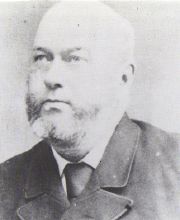
On January 27, 1868, Shogunate forces attacked the forces of ChÅshÅ« and Satsuma, clashing near Toba and Fushimi, at the southern entrance of Kyoto. Some parts of the 15,000-strong Shogunate forces had been trained by French military advisers, but the majority remained medieval samurai forces. Meanwhile, the forces of ChÅshÅ« and Satsuma were outnumbered 3:1 but fully modernized with Armstrong howitzers, Minié rifles and a few Gatling guns. After an inconclusive start,[25] on the second day, an Imperial pennant was remitted to the defending troops, and a relative of the Emperor, Ninnajinomiya Yoshiaki, was named nominal commander in chief, making the forces officially an imperial army (å®è» kangun).[26] Moreover, convinced by courtiers, several local daimyo, thitherto faithful to the Shogun, started to defect to the side of the imperial court. These included daimyo of Yodo on February 5, and the daimyo of Tsu on February 6, tilting the military balance in favour of the Imperial side.[27]
On February 7, Tokugawa Yoshinobu, apparently distressed by the imperial approval given to the actions of Satsuma and ChÅshÅ«, fled Osaka aboard the KaiyÅ Maru, withdrawing to Edo. Demoralized by his flight and by the betrayal by Yodo and Tsu, Shogunate forces retreated, making the Toba-Fushimi encounter an Imperial victory, although it is often considered the Shogunate forces should have won the encounter.[28] Osaka Castle was soon invested on February 8 (on March 1, Western calendar), putting an end to the battle of Toba-Fushimi.[29]
At the same time, on January 28, 1868, the naval Battle of Awa between the Shogunate and elements of the Satsuma Navy took place. This was Japan's first engagement between two modern navies.[30] The battle, although small in scale, ended in favor of the Shogunate.
On the diplomatic front, the ministers of foreign nations, gathered in the open harbor of HyÅgo (present day Kobe) in early February, issued a declaration according to which the Shogunate was still considered the only rightful government in Japan, giving hope to Tokugawa Yoshinobu that foreign nations (especially France) might consider an intervention in his favour. A few days later however an Imperial delegation visited the ministers declaring that the Shogunate was abolished, that harbours would be open in accordance with International treaties, and that foreigners would be protected. The ministers finally decided to recognize the new government.[31]
The rise of anti-foreign sentiment nonetheless led to several attacks on foreigners in the following months. Eleven French sailors from the corvette Dupleix were killed by samurai of Tosa in the Sakai incident on March 8, 1868. Fifteen days later, Sir Harry Parkes, the British ambassador, was attacked by a group of samurai in a street of Kyoto.[32]
Surrender of Edo
Beginning in February, with the help of the French ambassador Léon Roches, a plan was formulated to stop the imperial court's advance at Odawara, the last strategic entry point to Edo, but Yoshinobu decided against the plan. Shocked, Léon Roches resigned from his position. In early March, under the influence of the British minister Harry Parkes, foreign nations signed a strict neutrality agreement, according to which they could not intervene or provide military supplies to either side until the resolution of the conflict.[33]
SaigÅ Takamori led the victorious imperial forces north and east through Japan, winning the Battle of KÅshÅ«-Katsunuma. He eventually surrounded Edo in May 1868, leading to its unconditional defeat after Katsu Kaishu, the Shogun's Army Minister, negotiated the surrender.[34] Some groups continued to resist after this surrender but were defeated in the Battle of Ueno.
Meanwhile, the leader of the Shogun's navy, Enomoto Takeaki, refused to surrender all his ships. He remitted just four ships, among them the Fujisan, but he then escaped north with the remnants of the Shogun's Navy (eight steam warships: Kaiten, BanryÅ«, Chiyodagata, ChÅgei, KaiyÅ Maru, Kanrin Maru, Mikaho and Shinsoku), and 2,000 members of the navy, in the hope of staging a counter-attack together with the northern daimyo. He was accompanied by a handful of French military advisers, notably Jules Brunet, who had formally resigned from the French Army in order to accompany the rebels.[35]
Resistance of the Northern Coalition
After Yoshinobu's surrender,[36] most of Japan accepted the emperor's rule, but a core of domains in the North, supporting the Aizu clan, continued the resistance.[37] In May several northern daimyo formed an Alliance to fight Imperial troops, the coalition of northern domains composed primarily of forces from the domains of Sendai, Yonezawa, Aizu, Shonai and Nagaoka, with a total of 50,000 troops.[38] An Imperial Prince, Kitashirakawa Yoshihisa had fled north with partisans of the Tokugawa shogunate and was made the nominal head of the Northern Coalition, with the intention of naming him "Emperor Tobu."
Enomoto's fleet joined Sendai harbour on August 26. Although the Northern Coalition was numerous, it was poorly equipped, and relied on traditional fighting methods. Modern armament was scarce, and last-minute efforts were made to build cannons made of wood and reinforced with roping, firing stone projectiles. Such cannons, installed on defensive structures, could only fire four or five projectiles before bursting.[39] On the other hand, the daimyo of Nagaoka managed to procure two of the three Gatling guns in Japan and 2000 modern French rifles from the German weapons dealer Henry Schnell.
In May 1868, the daimyo of Nagaoka inflicted high losses on the Imperial troops in the Battle of Hokuetsu, but his castle ultimately fell on May 19. Imperial troops continued to progress north, defeating the Shinsengumi at the Battle of Bonari Pass, which opened the way for their attack on the castle of Aizu-Wakamatsu in the Battle of Aizu in October 1868, thus making the position in Sendai untenable.
The coalition crumbled, and on October 12, 1868 the fleet left Sendai for HokkaidÅ, after having acquired two more ships (Oe and HÅÅ, previously borrowed by Sendai from the Shogunate), and about 1,000 more troops: remaining Shogunate troops under Otori Keisuke, Shinsengumi troops under Hijikata Toshizo, the guerilla corps (yugekitai) under Hitomi KatsutarÅ, as well as several more French advisers (Fortant, Garde, Marlin, Bouffier).[35]
On October 26, Edo was renamed Tokyo, and the Meiji period officially started. Aizu was besieged starting that month, leading to the mass suicide of the Byakkotai (White Tiger Corps) young warriors. After a protracted month-long battle, Aizu finally admitted defeat on November 6.
HokkaidÅ campaign
Creation of the Ezo Republic
Following defeat on HonshÅ«, Enomoto Takeaki fled to HokkaidÅ with the remnants of the navy and his handful of French advisers. Together they organized a government, with the objective of establishing an independent island nation dedicated to the development of HokkaidÅ. They formally established the Republic of Ezo on the American model on December 25, Japan's only republic ever, and Enomoto was elected as President, with a large majority. The republic tried to reach out to foreign legations present in Hakodate, such as the Americans, French, and Russians, but was not able to garner any international recognition or support. Enomoto offered to confer the territory to the Tokugawa Shogun under Imperial rule, but his proposal was declined by the Imperial Governing Council.[40]
During the winter, they fortified their defenses around the southern peninsula of Hakodate, with the new fortress of Goryokaku at the center. The troops were organized under a Franco-Japanese command, the commander-in-chief Otori Keisuke being seconded by the French captain Jules Brunet, and divided between four brigades. Each of these was commanded by a French non-commissioned officer (Fortant, Marlin, Cazeneuve, Bouffier), and were themselves divided into eight half-brigades, each under Japanese command.[41]
Final losses and surrender

The Imperial navy reached the harbor of Miyako on March 20, but anticipating the arrival of the imperial ships, the Ezo rebels organized a daring plan to seize the Kotetsu. Led by Shinsengumi commander Hijikata Toshizo, three warships were dispatched for a surprise attack, in what is known as the Naval Battle of Miyako. The battle ended in failure for the Tokugawa side, owing to bad weather, engine trouble and the decisive use of a Gatling gun by Imperial troops against samurai boarding parties.[42]

Imperial forces soon consolidated their hold on mainland Japan, and, in April 1869, dispatched a fleet and an infantry force of 7000 to Ezo, starting the Battle of Hakodate. The Imperial forces progressed swiftly and won the naval engagement at Hakodate Bay, Japan's first large-scale naval battle between modern navies, as the fortress of Goryokaku was surrounded with 800 remaining men. Seeing the situation had become desperate, the French advisers escaped to a French ship stationed in Hakodate Bay - Coëtlogon, under the command of Dupetit-Thouars - from where they were shipped back to Yokohama and then France. The Japanese requested that the French advisers be given judgement in France; however, due to popular support in France for their actions, the former French advisers in Japan were not punished for their actions.
Enomoto had resolved to fight to the end, and had sent his valuables to his adversary for safekeeping.[43] but Otori convinced him to surrender, telling him that deciding to live through defeat is the truly courageous way: "If it's dying you want you can do it anytime."[44] Enomoto surrendered on May 18, 1869, and accepted the Meiji Emperor's rule. The Ezo Republic ceased to exist on June 27, 1869.
Aftermath
Following victory, the new government proceeded with unifying the country under a single, legitimate and powerful rule by the imperial court. The emperor's residence was effectively transferred from Kyoto to Tokyo at the end of 1868. The military and political power of the domains was progressively eliminated, and the domains themselves were soon transformed into prefectures, whose governors were appointed by the emperor. A major reform was the effective expropriation and abolition of the samurai class, allowing many samurai to change into administrative or entrepreneurial positions, but forcing many others into poverty.[45] The southern domains of Satsuma, ChÅshÅ« and Tosa, having played a decisive role in the victory, occupied most of the key posts in government for several decades following the conflict, a situation sometimes called the "Meiji oligarchy" and formalized with the institution of the genrÅ.[46] In 1869, the Yasukuni Shrine in Tokyo was built in honour of the victims of the Boshin War.[47]
Some leading partisans of the former Shogun were imprisoned, but narrowly escaped execution. This clemency derives from the insistence of SaigÅ Takamori and Iwakura Tomomi, although much weight was placed on the advice of Parkes, the British envoy. He had urged SaigÅ, in the words of Ernest Satow, "that severity towards Keiki [Yoshinobu] or his supporters, especially in the way of personal punishment, would injure the reputation of the new government in the opinion of European Powers."[48] After two or three years of imprisonment, most of them were called to serve the new government, and several pursued brilliant careers. Enomoto Takeaki, for instance, would later serve as an envoy to Russia and China and as the education minister.[49]
The Imperial side did not pursue its objective to expel foreign interests from Japan, but instead shifted to a more progressive policy aiming at the continued modernization of the country and the renegotiation of unequal treaties with foreign powers, later under the "rich country, strong army" (å¯å½å¼·å µ fukoku kyÅhei) motto. The shift in stance towards the foreigners came during the early days of the civil war: on April 8, 1868, new signboards were erected in Kyoto (and later throughout the country) that specifically repudiated violence against foreigners.[50] During the course of the conflict, Emperor Meiji personally received European envoys, first in Kyoto, then later in Osaka and Tokyo.[51] Also unprecedented was Emperor Meiji's reception of Alfred, Duke of Edinburgh, in Tokyo, "'as his equal in point of blood.'"[52]
Although the early Meiji era witnessed a warming between the imperial court and foreign powers, relations with France temporarily soured due to the initial support by France for the Shogun. Soon however a second military mission was invited to Japan in 1874, and a third one in 1884. A high level of interaction resumed around 1886, when France helped build the Imperial Japanese Navy's first large-scale modern fleet, under the direction of naval engineer Louis-Ãmile Bertin.[53] The modernization of the country had in fact already started extensively during the last years of the Shogunate, and the Meiji government ultimately adopted the same orientation, although it was better able to mobilize the whole country towards modernization in a more efficient way.

Upon his coronation, Meiji issued his Charter Oath, calling for deliberative assemblies, promising increased opportunities for the common people, abolishing the "evil customs of the past," and seeking knowledge throughout the world "to strengthen the foundations of imperial rule."[54] Prominent reforms of the Meiji government included the 1871 abolition of the domain system, by which the feudal domains and their hereditary rulers were replaced by prefectures with governors appointed by the emperor.[55] Others included the introduction of compulsory schooling and the abolition of Confucian class distinctions. The reforms culminated in the 1889 issuance of the Meiji Constitution. However, despite the support given to the imperial court by samurai, many of the early Meiji reforms were seen as detrimental to their interests: the creation of a conscript army made of commoners, as well as the loss of hereditary prestige and stipends antagonized many former samurai.[56] Tensions ran particularly high in the south, leading to the 1874 Saga Rebellion, and a rebellion in ChÅshÅ« in 1876. Former samurai in Satsuma, led by Saigo Takamori, who had left government over foreign policy differences, started the Satsuma Rebellion in 1877. Fighting for the maintenance of the samurai class and a more virtuous government, their slogan was "new government, high morality" (æ°æ¿åå¾³ shinsei kÅtoku). It ended with a heroic but total defeat at the Battle of Shiroyama.[57]
Legacy: Political
The Boshin War contributed to Japan's more militant and expansionist policy that, in the next century, propelled her into imperial competition with other powers, to colonial ambition in Korea, Manchuria and throughout Asia and the Pacific leading up to and during World War II. Following defeat in 1945, Japan had redirected her creativity, ingenuity and energy into becoming an economic power, rather than a military one. Many people in Japan, originally a nation of "great harmony," feel that they should contribute their various resources for the sake of the world in order to atone for their past militaristic aggressions.
Cultural Legacy

In modern summaries, the Meiji restoration is often described as a "bloodless revolution" leading to the sudden modernization of Japan. The actual facts of the Boshin War clearly show that the conflict was quite violent: about 120,000 troops were mobilized altogether with roughly 3500 known casualties.[1] Later Japanese depictions of the war tended to be highly romanticized, showing the Shogunal side fighting with traditional methods, against an already modernized Imperial side. And although traditional weapons and techniques were used, both sides employed some of the most modern armaments and fighting techniques of the period: including the ironclad warship, Gatling guns, and fighting techniques learned from Western military advisers.
Such Japanese depictions include numerous dramatizations, spanning many genres. Notably, JirÅ Asada wrote a four-volume novel of the account, Mibu Gishi-den. A film adaptation of Asada's work, directed by Yojiro Takita, is known as When the Last Sword Is Drawn.[60] A ten-hour television jidaigeki based on the same novel starred Ken Watanabe. The 2001 Goryokaku film is another jidaigeki highlighting the resistance in Hokkaido. The famous Japanese anime Rurouni Kenshin is set ten years after the Boshin War.
Elsewhere, the 2003 Hollywood movie The Last Samurai[61] combines into a single narrative historical situations belonging both to the Boshin War, the 1877 Satsuma Rebellion, and other similar uprisings of ex-samurai during the early Meiji period. The elements of the movie pertaining to the early modernization of Japan's military forces as well as the direct involvement of foreign (mostly French) forces relate to the Boshin War and the few years leading to it. However, the suicidal stand of traditionalist samurai forces led by SaigÅ Takamori against the modernized Imperial army relate to the much later Satsuma Rebellion.
Notes
- â 1.0 1.1 1.2 KÅichi Hagiwara. 2004. (Japanese) Illustrated life of SaigÅ Takamori and Okubo Toshimichi. (Tokyo, JP: Kawade ShobÅ Shinsya. ISBN 4309760414), 50.
- â Thanks to the interaction with the Dutch, the study of Western science continued during this period under the name of Rangaku, allowing Japan to study and follow most of the steps of the scientific and industrial revolution. Marius B. Jansen. 1999. "The Nineteenth Century," vol. 5. The Cambridge History of Japan. (Cambridge, UK: Cambridge University Press. ISBN 0521657288), 210â215, discusses the vibrancy of Edo period rangaku, and later, 346, notes the competition in the early Meiji period for foreign experts and rangaku scholars.
- â Timon Screech. 2006. The technology of Edo. (Tokyo, JP: SÅ«kenshuppan. ISBN 4410138863) (in Japanese) ; Screech, 1999. The intellectual world of Edo. (Tokyo, JP: Seidosha. ISBN 4791756908) (Japanese)
- â Hagiwara, 2004, 34.
- â Jansen, 2002, 314â315.
- â Hagiwara, 2004, 35.
- â Jansen, 2002, 303â305.
- â Hagiwara, 2004, 34â35.
- â As early as 1865, Thomas Blake Glover sold 7500 Minié rifles to the ChÅshÅ« clan, allowing it to become totally modernized. Nakaoka Shintaro a few months later remarked that "in every way the forces of the han have been renewed; only companies of rifle and cannon exist, and the rifles are Minies, the cannon breech loaders using shells." Sidney DeVere Brown, Nagasaki in the Meiji Restoration: Choshu loyalists and British arms merchants. uwosh.edu. Retrieved January 25, 2009.
- â This is a claim made by Jules Brunet in a letter to Napoleon III: "I must signal to the Emperor the presence of numerous American and British officers, retired or on leave, in this party [of the southern daimyo] which is hostile to French interests. The presence of Western leaders among our enemies may jeopardize my success from a political standpoint, but nobody can stop me from reporting from this campaign information Your Majesty will without a doubt find interesting." Original quotation (French): "Je dois signaler à l'Empereur la présence de nombreux officers américains et anglais, hors cadre et en congé, dans ce parti hostile aux intérêts français. La présence de ces chefs occidentaux chez nos adversaires peut m'empêcher peut-être de réussir au point de vue politique, mais nul ne pourra m'empêcher de rapporter de cette campagne des renseignements que Votre Majesté trouvera sans doute intéressants." Christian Polak. 2002. (Japanese) (French) Soie et Lumière, L'Ãge d'or des échanges Franco-Japonais. (Tokyo, JP: Hachette Fujingaho. ISBN 4573062106), 81. As an example, the English Lieutenant Horse is known to have been a gunnery instructor for the Saga domain during the Bakumatsu period. TÅgÅ Shrine and TÅgÅ Association. Togo Heihachiro in Images: Illustrated Meiji Navy. (Tokyo), 17 (in Japanese).
- â These encounters are described in: Ernest Satow. (1869). A Diplomat in Japan. (Tokyo, JP; London: Stone Bridge Press, 2007. ISBN 1933330163) Where he famously describes SaigÅ as a man with "an eye that sparkled like a big black diamond."
- â For example, An 1864 request to Sir Rutherford Alcock to supply British military experts from the 1,500 men stationed at Yokohama went unanswered, and when Takenaka Shibata visited United Kingdom and France, in September 1865, requesting assistance, only the latter was forthcoming.
- â Following the deal with France, the French ambassador in Japan Leon Roches, trying not to alienate United Kingdom, arranged for the Shogun to ask for a British navy mission which arrived sometime after the French military mission of 1867. Christian Polak. (Japanese) (French) 2002. Soie et Lumière, L'Ãge d'or des échanges Franco-Japonais. (Tokyo, JP: Hachette Fujingaho. ISBN 4573062106), 53â55.
- â Donald Keene. 2005. Emperor of Japan: Meiji and His World, 1852â1912. (New York, NY: Columbia. ISBN 023112340X), 165â166.
- â Jansen, 2002, 307.
- â There is debate as to the authenticity of the order, due to its violent language and the fact that, despite using the imperial pronoun (æ chin), it did not bear Meiji's signature. Keene, 2005, 115â116.
- â Satow, 1921, 282.
- â Keene, 2005, 116. See also Jansen, 2002, 310â311.
- â Keene, 2005, 120â121, and Satow, 1921, 283. Moreover, Satow, 285, speculates that Yoshinobu had agreed to an assembly of daimyos on the hope that such a body would restore him.
- â Satow, 286.
- â During a recess, SaigÅ, who had his troops outside, "remarked that it would take only one short sword to settle the discussion." Original quotation (Japanese): "çåä¸æ¬ããã°ããã¥ããã¨ã ." in Hagiwara, 2004, 42. The specific word used for "dagger" was "tantÅ."
- â Keene, 2005, 124.
- â Keene, 2005, 125.
- â Hagiwara, 2004, 63.
- â SaigÅ, while excited at the beginning of combat, had planned for the evacuation of the emperor from Kyoto if the situation demanded it. Keene, 2005, 125â126.
- â The red and white pennant had been conceived and designed by Okubo Toshimichi and Iwakura Tomomi, among others. It was in effect a forgery, as was the imperial order to deploy it among the defending troops. Prince Yoshiaki, was also given a special sword and appointed "great general, conqueror of the east," and the Shogunal forces opposing Yoshiaki were branded "enemies of the court." Keene, 2005, 126â127.
- â A detailed description of the battle is available in Hagiwara, 2004, 42.
- â "Militarily, the Tokugawa were vastly superior. They had between three to five times more soldiers and held Osaka Castle as a base, they could count on the forces from Edo modernized by the French, and they had the most powerful fleet of East Asia at hand in Osaka Bay. In a regular fight, the Imperial side had to lose. SaigÅ Takamori too, anticipating defeat had planned to move the Emperor to the ChÅ«goku mountains and was preparing for guerilla warfare." Hagiwara, 2004, 43. Translation from the Japanese original.
- â Hagiwara, 2004, 43â45.
- â TÅgÅ Shrine, and TÅgÅ Association.
- â Polak, 2002, 75.
- â Le Monde Illustré (Paris), 583.
- â Polak, 2002, 77.
- â Hagiwara, 2004, 46.
- â 35.0 35.1 Polak, 2002, 81.
- â Tokugawa Yoshinobu was placed under house arrest, and stripped of all titles, land and power. He was later on released, when he demonstrated no further interest and ambition in national affairs. He retired to Shizuoka, the place to which his ancestor Tokugawa Ieyasu, had also retired.
- â Harold Bolitho. 1974. Treasures among Men: The Fudai Daimyo in Tokugawa Japan. (New Haven, CT: Yale University Press), 246; John R. Black. (1881). Young Japan: Yokohama and Yedo, vol. II. (London, UK: Trubner & Co.; reprint: Elibron Classics a facsimile reprint of a 1881 ed. Adamant, 2001. ISBN 1402193742), 214.
- â Polak, 2002, 79â91. Apart from those core domains, most of the northern domains were part of the alliance.
- â A detailed presentation of artifacts from that phase of the war is visible at the Sendai City Museum, in Sendai, Japan.
- â In a letter of Enomoto to the Imperial Governing Council: "We pray that this portion of the Empire may be conferred upon our late lord, Tokugawa Kamenosuke; and in that case, we shall repay your beneficence by our faithful guardianship of the northern gate." Black, 1881, 240â241.
- â Polak, 2002, 85â89.
- â Collache was onboard one of the ships that participated to the attack. He had to wreck his ship and flee overland, until he surrendered with his colleagues and was transferred to a prison in Tokyo. He ultimately returned to France safely to tell his story. The encounter is detailed in Eugène Collache. 1874. "'Une aventure au Japon." Le Tour du Monde, 77.
- â These included the Naval Codes he had brought back from Holland, which he entrusted to the general of the Imperial troops, Kuroda Kiyotaka.
- â Christian Polak et al. 1988. (Japanese) End of the Bakufu and Restoration in Hakodate (Hakodate no bakumatsu ishin: Furansu shikan Buryune no suketchi 100-mai). (Tokyo, JP: Chuo Koronsha. ISBN 4120016994.)
- â Most legal distinctions between samurai and ordinary subjects were soon abolished, and the traditional rice stipends paid to samurai were first converted into cash stipends, and these were later converted at a steep discount to government bonds. Andrew Gordon. 2003. A Modern History of Japan. (New York, NY: Oxford. ISBN 0195110609.)
- â For example Saigo Takamori, Okubo Toshimichi, and TÅgÅ HeihachirÅ all came from Satsuma. Discussed in Togo Heihachiro in images: Illustrated Meiji Navy. (TÅgÅ Shrine and TÅgÅ Association.)
- â Koizumi shrine visit stokes anger. BBC News. Retrieved January 25, 2009.
- â Donald Keene. 2005. Emperor of Japan: Meiji and His World, 1852â1912. (New York, NY: Columbia. ISBN 023112340X), 143.
- â Polak et al., 1988; Keene, 2005.
- â Keene, 2005, 142.
- â Keene, 2005, 143â144, 165.
- â Parkes, quoted in Keene, 2005, 183-187. Emphasis in the original.
- â David Evans, and Mark Peattie. 1997. Kaigun: Strategy, Tactics, and Technology in the Imperial Japanese Navy, 1887â1941. (Annapolis, MD: Naval Institute Press. ISBN 0870211927)
- â Jansen, 2002, 338, 337-343 for political developments during and relating to the course of the war; Keene, 2005, 138â142, for discussion of the Charter Oath and signboard decrees.
- â Many daimyo were appointed as the first governors, and subsequently given peerages and large pensions. Over the following years, the three hundred domains were reduced to fifty prefectures. Jansen, 2002, 348â349.
- â Jansen, 2002, 367â368.
- â Hagiwara, 2004, 94â120. SaigÅ himself professed continued loyalty to Meiji and wore his Imperial Army uniform throughout the conflict. He committed suicide before the final charge of the rebellion, and was posthumously pardoned by the emperor in subsequent years. Jansen, 2002, 369â370.
- â The Shogunate leaders are labeled from left to right, Enomoto (Kinjiro) Takeaki, Otori Keisuke, Matsudaira Taro. The samurai in yellow garment is Hijikata Toshizo.
- â The "Red bear" (赤ç Shaguma) wigs indicate soldiers from Tosa, the "White bear" (ç½ç Haguma) wigs for ChÅshÅ«, and the "Black bear" (é»ç Koguma) wigs for Satsuma.
- â "When the Last Sword Is Drawn/Mibu gishi den." 2005. SIGHT AND SOUND. 15 (1): 72.
- â Tom Cruise, Marshall Herskovitz, Edward Zwick, John Logan, Ken Watanabe, William Atherton, Billy Connolly, et al. 2004. The last samurai. (Burbank, CA: Warner Home Video. ISBN 9780790782768)
ReferencesISBN links support NWE through referral fees
- BBC Koizumi shrine visit stokes anger. BBC News (August 15, 2006). Retrieved April 28, 2020.
- Black, John R. Young Japan: Yokohama and Yedo, Vol. II. London, UK: Trubner & Co. reprint: Elibron Classics 2001 (original 1881). ISBN 1402193742
- Bolitho, Harold. Treasures among Men: The Fudai Daimyo in Tokugawa Japan. New Haven, CT: Yale University Press, 1974. ISBN 978-0300016550
- Brown, Sidney DeVere. Nagasaki in the Meiji Restoration: Choshu loyalists and British arms merchants. uwosh.edu. Retrieved April 28, 2020.
- Collache, Eugène. "Une aventure au Japon." Le Tour du Monde 77 (1874).
- Evans, David, and Mark Peattie. Kaigun: Strategy, Tactics, and Technology in the Imperial Japanese Navy, 1887â1941. Annapolis, MD: Naval Institute Press, 1997. ISBN 0870211927
- Gordon, Andrew. A Modern History of Japan. New York, NY: Oxford, 2003. ISBN 0195110609
- Hagiwara, KÅichi. (Japanese) Illustrated life of SaigÅ Takamori and Okubo Toshimichi. Tokyo, JP: Kawade ShobÅ Shinsya, 2004. ISBN 4309760414
- Jansen, Marius B. "The Nineteenth Century," vol. 5. The Cambridge History of Japan. Cambridge, UK: Cambridge University Press, 1999. ISBN 0521657288.
- Jansen, Marius B. The Making of Modern Japan. Cambridge, MA: Harvard University Press, 2002. ISBN 0674009916
- Keene, Donald. Emperor of Japan: Meiji and His World, 1852â1912. New York, NY: Columbia University Press, 2005. ISBN 023112340X
- Le Monde Illustré Paris: 1868. 583.
- Polak, Christian. (Japanese) (French) Soie et Lumière, L'Ãge d'or des échanges Franco-Japonais. Tokyo, JP: Hachette Fujingaho, 2002.
- Polak, Christian, et al. (Japanese) End of the Bakufu and Restoration in Hakodate (Hakodate no bakumatsu ishin: Furansu shikan Buryune no suketchi 100-mai). Tokyo, JP: Chuo Koronsha, 1988. ISBN 4120016994
- Ravina, Mark. The Last Samurai: The Life and Battles of SaigÅ Takamori. New York, NY: Wiley, 2005. ISBN 0471705373
- Satow, Ernest. A Diplomat in Japan. Tokyo, JP: Oxford, 1968.
- Screech, Timon. (Japanese) The intellectual world of Edo. Tokyo, JP: Seidosha, 1999. ISBN 4791756908
- Screech, Timon. (Japanese) The technology of Edo. Tokyo, JP: SÅ«kenshuppan, 2006. ISBN 4410138863
- TÅgÅ Shrine and TÅgÅ Association. (Japanese) Togo Heihachiro in Images: Illustrated Meiji Navy.
Credits
New World Encyclopedia writers and editors rewrote and completed the Wikipedia article in accordance with New World Encyclopedia standards. This article abides by terms of the Creative Commons CC-by-sa 3.0 License (CC-by-sa), which may be used and disseminated with proper attribution. Credit is due under the terms of this license that can reference both the New World Encyclopedia contributors and the selfless volunteer contributors of the Wikimedia Foundation. To cite this article click here for a list of acceptable citing formats.The history of earlier contributions by wikipedians is accessible to researchers here:
The history of this article since it was imported to New World Encyclopedia:
Note: Some restrictions may apply to use of individual images which are separately licensed.
